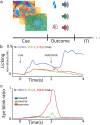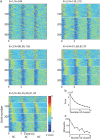Temporal convergence of dynamic cell assemblies in the striato-pallidal network
- PMID: 22396421
- PMCID: PMC6621802
- DOI: 10.1523/JNEUROSCI.4830-11.2012
Temporal convergence of dynamic cell assemblies in the striato-pallidal network
Abstract
The basal ganglia (BG) have been hypothesized to implement a reinforcement learning algorithm. However, it is not clear how information is processed along this network, thus enabling it to perform its functional role. Here we present three different encoding schemes of visual cues associated with rewarding, neutral, and aversive outcomes by BG neuronal populations. We studied the response profile and dynamical behavior of two populations of projection neurons [striatal medium spiny neurons (MSNs), and neurons in the external segment of the globus pallidus (GPe)], and one neuromodulator group [striatal tonically active neurons (TANs)] from behaving monkeys. MSNs and GPe neurons displayed sustained average activity to cue presentation. The population average response of MSNs was composed of three distinct response groups that were temporally differentiated and fired in serial episodes along the trial. In the GPe, the average sustained response was composed of two response groups that were primarily differentiated by their immediate change in firing rate direction. However, unlike MSNs, neurons in both GPe response groups displayed prolonged and temporally overlapping persistent activity. The putamen TANs stereotyped response was characterized by a single transient response group. Finally, the MSN and GPe response groups reorganized at the outcome epoch, as different task events were reflected in different response groups. Our results strengthen the functional separation between BG neuromodulators and main axis neurons. Furthermore, they reveal dynamically changing cell assemblies in the striatal network of behaving primates. Finally, they support the functional convergence of the MSN response groups onto GPe cells.
Figures









References
-
- Alexander GE, DeLong MR. Microstimulation of the primate neostriatum. I. Physiological properties of striatal microexcitable zones. J Neurophysiol. 1985;53:1401–1416. - PubMed
-
- Apicella P, Ljungberg T, Scarnati E, Schultz W. Responses to reward in monkey dorsal and ventral striatum. Exp Brain Res. 1991;85:491–500. - PubMed
-
- Bagetta V, Picconi B, Marinucci S, Sgobio C, Pendolino V, Ghiglieri V, Fusco FR, Giampà C, Calabresi P. Dopamine-dependent long-term depression is expressed in striatal spiny neurons of both direct and indirect pathways: implications for Parkinson's disease. J Neurosci. 2011;31:12513–12522. - PMC - PubMed
-
- Bar-Gad I, Morris G, Bergman H. Information processing, dimensionality reduction and reinforcement learning in the basal ganglia. Prog Neurobiol. 2003;71:439–473. - PubMed
Publication types
MeSH terms
LinkOut - more resources
Full Text Sources
Research Materials
Miscellaneous
